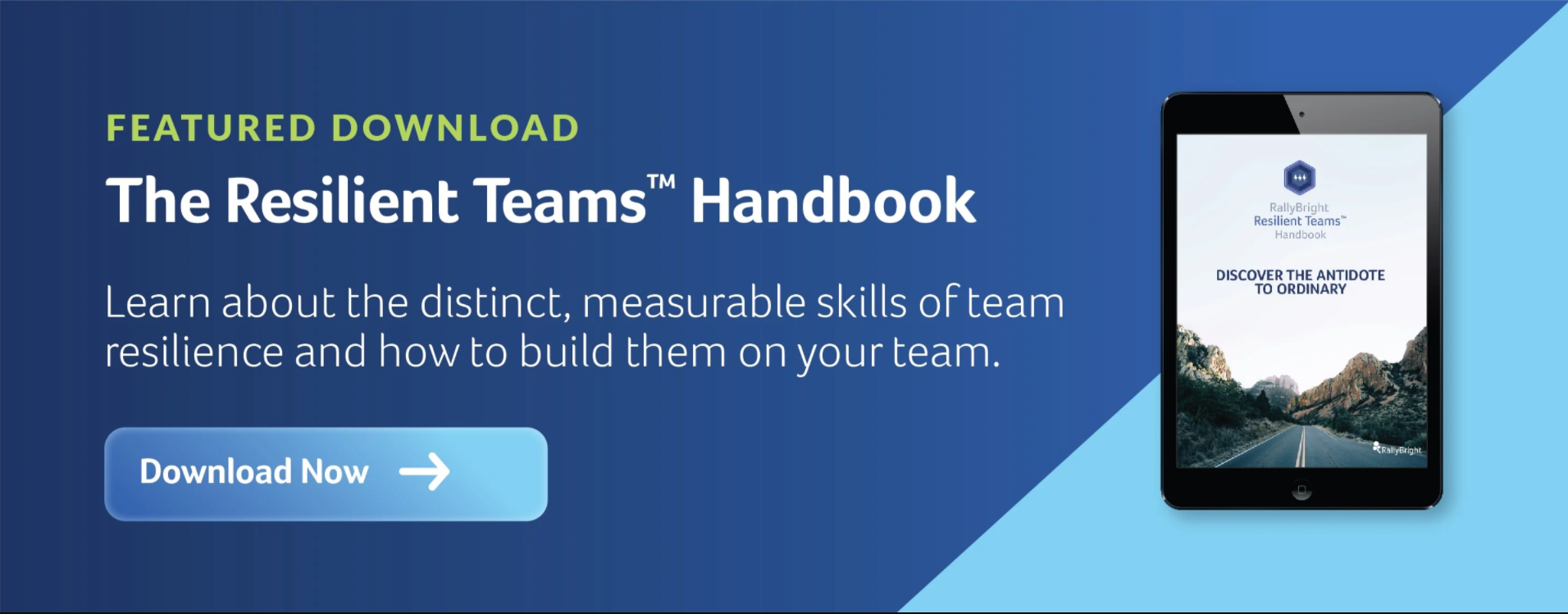This updated article was originally published in June 2020.
Gallup’s most recent report on employee engagement, from June 2021, puts engagement among American workers at 36%, up five percentage points from a year prior. This means that just over one third of American workers can be described as “involved in, enthusiastic about and committed to their work and workplace.” While it could be worse, that’s a fairly weak — and expensive — result for team engagement.
This isn’t just a worry for HR professionals who track engagement stats as a metric of their own success. Engagement should be a top-of-mind issue for every team leader because it’s crucial to a team’s ability to produce great business results over a sustained period of time. Disengaged teams may perform well for a time. But it takes deeply connected team members who trust and feel safe with one another — and who share a willingness to make individual sacrifices for the good of the whole — to make a team that prevails over the long haul.
When team engagement is low, the underlying culprit is often poor conflict management, low trust levels, and/or an absence of open communication. How can you tell if your team suffers from disengagement? Maybe there’s a lack of honest feedback or little to no social connection among team members. Or maybe your team has a high percentage of “Debbie Downers” or those that seem inflexible or sluggish. You might just sense that people seems mentally or professionally checked out. All of these can be signs. To better understand how engagement works, let’s take a closer look at the capabilities behind it.
Engagement’s Drivers: Connection and Attitude
Engagement is all about team dynamics. Highly engaged team members share trust, commitment and a constant drive to exceed their potential. They feel safe enough with each other to take risks and fail. When we assess these teams based on their five resilience attributes, they score high on both connection and attitude.
At RallyBright, when we talk about connection we mean a foundation in strong relationships and high trust. People on highly connected teams share a commitment to the wellbeing of the team as a whole. They are trusting and trustworthy, surface and resolve conflict productively, and are attentive to one another’s needs. Notably, connected teams have a high degree of what’s called “psychological safety” — a term coined by Harvard Business School professor Amy Edmondson that refers to “a shared belief that the team is safe for interpersonal risk-taking.” (In 2015, Google identified psychological safety as one one five key dynamics that successful teams share.)
Attitude, on the other hand, concerns optimism and agility. Teams that have an attitude that poises them for success have an ability to deliver impact. They do this via a competitive spirit, high energy, and the positive outlook associated with a “growth mindset.” These teams typically focus on excelling, demonstrate personal accountability and show a high willingness to adapt, learn and grow with transparency.
Engaged Teams Are Motivated Teams
While it’s not always the case, engaged teams generally tend to be motivated teams. This is particularly true of teams that are motivated by intrinsic (versus extrinsic) factors, such as a sense of pride or deep meaning in their work. Boost team engagement and you have a better chance of seeing that team energized to take initiative, tackle new or challenging projects, and hit performance goals.
Here are three good ways to keep your team motivated.
1. Build trust levels
Trust is easier to experience than to describe. Even psychologists have a hard time agreeing on what the term means. At RallyBright we describe trust as a spoken or unspoken contract between people that permits them to express their expectations. It means they feel safe confiding in, being vulnerable with, giving feedback to or disagreeing with one another. In our research we’ve found that there are three main ways to build and maintain trust:
- Explicitly communicating beliefs and expectations
- Acknowledging and accepting individual differences
- Letting go of the past (both individual and team histories)
For more on how people in high-trust environments thrive, check out this article by Stanford Business School professor Joel Peterson.
2. Remember to recognize
Everyone likes recognition for their unique talents and contributions. This kind of recognition results in more motivated employees and teammates. A 2009 study by the advisory firm Willis Towers Watson found that strong manager performance in recognizing employee performance increases engagement by almost 60 percent. Take the time to make your recognition personal and specific—this signals your commitment to your team, enhancing connection. A one-size-fits-all approach will feel insincere to the recipient.
3. Shape the right risk attitude for your team
What’s your team’s appetite for risk? Some teams we’ve assessed believe there is little margin for error and frown upon risk-taking. That makes sense in some cases. After all, you may not want a team of heart surgeons doing a risky procedure just to push the envelope. Alternatively, teams looking for new ways to delight customers through product features will need to think about taking risks.
As a leader, you’re crucial to shaping how your team approaches risk. The key is to foster a team culture where members are eager to take the risks worth taking, and where there’s an awareness that taking little or no risk is also a risk. An openness to risk at the leadership level helps drive the message that leaders recognize and value efforts to adapt, learn and grow — engines for deeper team engagement.
This Harvard Business Review article offers some actionable tips to encourage a risk-tolerant culture, including signaling attitude about risk through very intentional language.
Does your organization need an engagement recharge? See how your team’s connection and attitude scores stack up against the competition with our quantified and benchmarked team assessment. Sign up today for a free demo of RallyBright’s Resilient Teams™.



